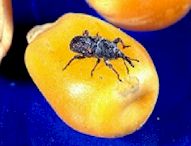
Very similar in appearance to the Rice Weevil with characteristics described above, except that the insects are longer, adults reaching a length of 3-3.5mm
The maize weevil is slightly larger than the rice weevil and has more distinct colored spots on the forewings. It is a stronger flier than the rice weevil. The habits and life cycle are similar to the rice weevil.
Sitophilus zeamais is the dominant species on maize
Eggs - Laid in stored cereal grains and in cereals in the field by flying adults (more prolific than granary weevil).
Larvae - Feed in grain.
Adults - Also feed; normally cannot over winter in temperate areas unless grain heats. Good flyer; larger than rice weevil.
Dry maize is not for human consumption but for animal feed and export. Because of problems with aflatoxin contamination and insect infestation, recent crops have met with reduced prices
Maize weevils carried a great collection of other fungi including A. niger, A. glaucus, A. candidus, Penicillium islandicum, P. citrinum, Paecilomyces, Acremonium, Epicoccum, F. semitectum, yeasts and many others.
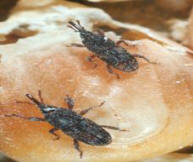 ability
of flight. All three weevils develop as larvae within the grain kernels.
They frequently cause almost complete destruction of grain in elevators
or bins, where conditions are favourable and the grain is undisturbed
for some length of time. Infested grain will usually be found heating at
the surface, and it may be damp, sometimes to such an extent that
sprouting occurs. Wheat, corn, macaroni, oats, barley, sorghum, Kaffir
seed, and buckwheat are just some of the grains and products on which
these weevils feed.
ability
of flight. All three weevils develop as larvae within the grain kernels.
They frequently cause almost complete destruction of grain in elevators
or bins, where conditions are favourable and the grain is undisturbed
for some length of time. Infested grain will usually be found heating at
the surface, and it may be damp, sometimes to such an extent that
sprouting occurs. Wheat, corn, macaroni, oats, barley, sorghum, Kaffir
seed, and buckwheat are just some of the grains and products on which
these weevils feed.The weevil (presumably) chews a small hole in the seed and lays an egg in the resulting cavity. The larva bores throughout the seed and pupates there, the adult emerging after it has matured.
Corn is a favorite host of the maize weevil, and can become infested in the field as well as in storage. The weevil (presumably) chews a small hole in the seed and lays an egg in the resulting cavity. The larva bores throughout the seed and pupates there, the adult emerging after it has matured. Like many other stored grain pests, Sitophilus species tolerate or prefer low moisture levels in their food.
The larva is dormant for four to five months during the winter in colder climates. There are generally four to five generations per year, although in heated warehouses there may be as many as 10 to 12 generations.
Food
Weevils can be found infesting a variety of grain and food materials. They attack all cereal grains, however are
most often found in corn, oats, barley, rye, and wheat.
They cannot breed in finely processed grain but will readily breed in manufactured products such as macaroni, noodles and milled cereals that have become caked from excessive moisture.
Rice and Maize Weevils are widely distributed in tropical and sub-tropical areas and will be carried to temperate areas on imported commodities. The Maize Weevil will breed on maize in the field.
Control
- The only way to control these pests is fumigation.
- Since it is an internal pest, residual control will only kill
- Exposed adults. To kill the internal stages (larval and pupal), you must fumigate. Heating grain to 60C can kill larvae; however, this may decrease germination and baking quality of flour.
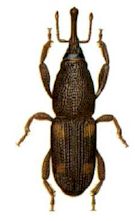 control can be attributed to application error, equipment failure or
less-than-optimal environmental conditions. If these possibilities have
been eliminated, work with local agricultural advisors and the
manufacturer to confirm resistance to the compound applied. In the event
of a control failure due to resistance, do not respray with an
insecticide of the same chemical class.
control can be attributed to application error, equipment failure or
less-than-optimal environmental conditions. If these possibilities have
been eliminated, work with local agricultural advisors and the
manufacturer to confirm resistance to the compound applied. In the event
of a control failure due to resistance, do not respray with an
insecticide of the same chemical class.Prevention is the best strategy to avoid insect problems in stored grains. Proper bin sanitation before introduction of new grain minimizes the need for pesticides. Good sanitation involves the removal of old grain and dust in and around the grain bin. This includes removal of old grain from corners, floors, and walls and grain that may have spilled on the exterior of the bin. Any grain remaining when a bin is emptied can harbor insect infestations which will move into the new grain.
After the bin is cleaned, and all needed repairs have been made, the
floor and wall surfaces both inside and outside the bin should be
treated. Take special care to treat all cracks, crevices, and areas
around doorways and other places where insects could hide or enter.
Spray the bins about four to six weeks prior to storing grain.
Before grain is placed in a bin, it should be screened to eliminate fine
materials and broken kernels. Grain placed in a clean bin should be
checked at two week intervals during warm months and at one month
intervals during cooler months for the presence of hotspots, moldy
areas, and live insects. If any of these conditions exist, the grain
should be aerated to lower the moisture level and temperature.
Grain that is to be stored for longer than six months may need a
protective application of an approved insecticide. Treatments can be
applied as the grain is loaded into the bin through the use of a
metering device calibrated to apply the proper amounts. After the grain
is binned and leveled, a surface dressing can be applied to prevent
insects from entering the grain on the surface. If infestation occurs in
spite of these precautions, fumigation of the grain will be necessary.
Because of the high toxicity of registered fumigants and technical
knowledge needed for their proper use, a qualified pesticide applicator
should be contacted to perform the fumigation.
Since it is an internal pest, residual control will only kill exposed adults. To kill the internal stages (larval and pupal), you must
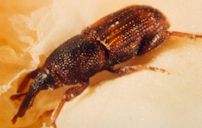 fumigate. Heating grain to 60C can kill larvae, however, this may
decrease germination and
fumigate. Heating grain to 60C can kill larvae, however, this may
decrease germination andbaking quality of flour.
“If you dry corn in the field, the corn will become infested with maize weevils,” says Extension agricultural engineer Paul Sumner. “Once a weevil feeds on an ear of corn it'll emit a pheromone which will attract other maize weevils to that area. They subsequently lay eggs in the mature kernels, and adult weevils emerge within 2-3 weeks.” By delaying harvest in the field, growers allow a second infestation of weevils in the corn, says Sumner. “It's going to occur anyway in our part of the country. Do you leave corn in the field and let it dry, or do you harvest it after it has field dried? Then, do you store it or sell it immediately?”
If you plan on storing corn, then you'll have to place some insecticide on it to prevent a regular occurring infestation of weevils inside the storage bin, he says.
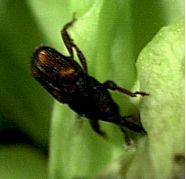
Storage of grains for a month or more during the warm, summer months may lead to infestations. Purchase grains in small quantities for early use, and store in containers of insect-proof glass, heavy plastic, or metal with screw-type, airtight lids. For longer storage, refrigerate or deep freeze.
At the time of purchase, carefully examine whole grains, such as wheat, oats, rye, buckwheat, barley, corn, rice, birdseed, nuts, table beans, etc. for weevil infestations. Especially check grains purchased from grain storage facilities, processing plants, and stores. Fortunately, all stages of these weevils can be killed easily by super heating or cooling. Heat in a shallow pan in the oven at 120 degrees F for 1 hour or at 130 degrees F for 30 minutes, place in a deep freeze at 0 degrees F for 4 days, or heat in the microwave for 5 minutes. However, seeds saved for planting may have the germination reduced by super heating, cooling, or microwave methods. Properly ventilate the storage area to discourage these moisture-loving stored product pests. Be sure to store only clean, dry grain with a moisture content of 12 percent or less to reduce weevil problems.